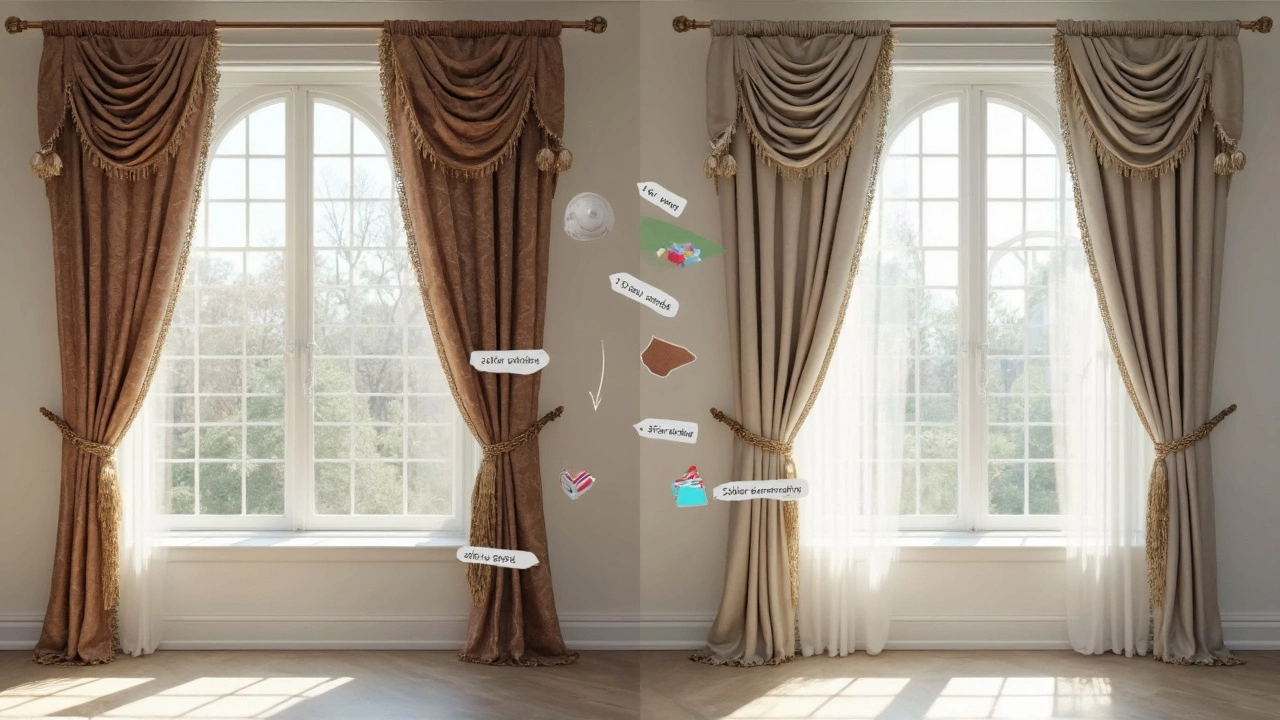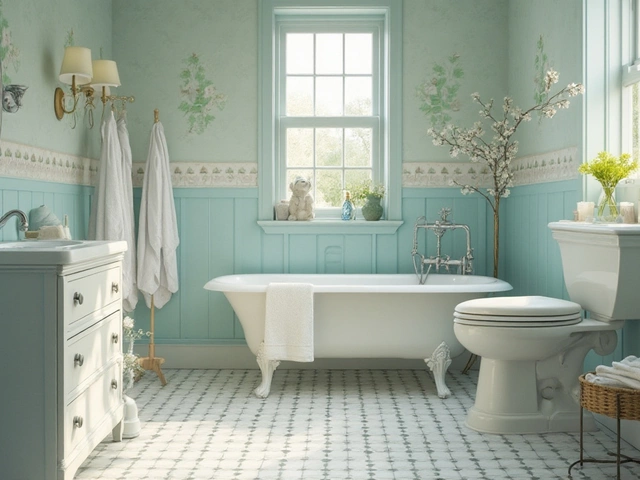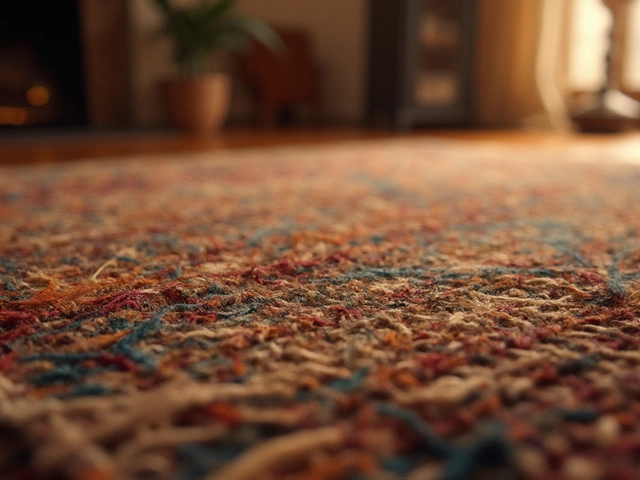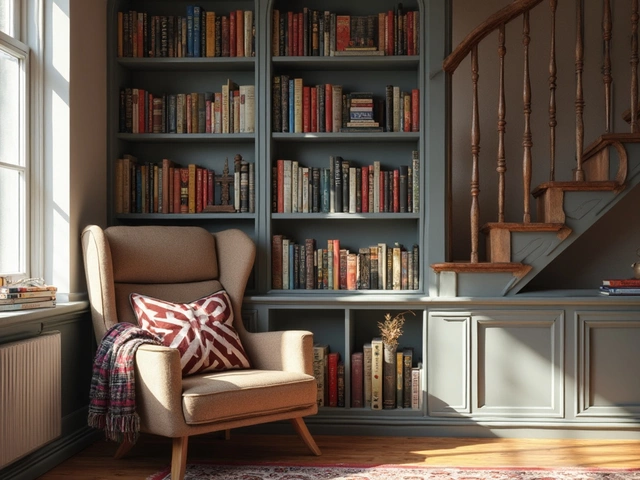Ever wonder why some window coverings seem to have a heftier price tag than others? If you’ve stared at home decor websites, you’ve probably noticed drapes usually cost more than regular curtains. But is that always true? And what’s really behind the price difference?
Let’s strip away the marketing fluff. There’s a lot more to the story than just fabric hanging from a rod. The price depends on design, materials, size, and even the type of lining tucked in. A lining can add warmth, block light, and surprisingly, bump up the cost more than you’d think.
Anyone who’s watched their budget melt away at a home improvement store knows that tiny details—like pleats or the difference between blackout and sheer—can mean a big jump in your final bill. Sometimes, it’s not just about spending more money, but knowing what you’re actually getting for it.
- What’s the Difference Between Drapes and Curtains?
- Why Drapes Usually Cost More
- What Impacts the Price Tag?
- How to Save Money on Window Coverings
- Choosing What’s Right for Your Home
What’s the Difference Between Drapes and Curtains?
People often swap the words drapes and curtains like they’re exactly the same. The truth? There are some key differences, and knowing these can save you time and money when you’re shopping for window treatments.
Curtains are the more casual option. They usually come in lighter fabrics (think cotton or linen) and often hang just below the window sill or to the floor. You’ll see them everywhere—from bedrooms to kitchens. Curtains are usually unlined or just lightly lined, so they let plenty of sunlight through. That makes them perfect if you like bright rooms or want something quick and easy to switch out with the seasons.
Drapes, on the other hand, are the heavier hitters—literally. Drapes are made from thick, sometimes luxurious materials like velvet or heavy polyester. Most of the time, they’ve got backing or lining that can block out nearly all light. That’s why you see drapes in hotels or fancy living rooms. Their full length goes from ceiling to floor, which adds to their dramatic look. This extra fabric and lining are usually the reason for their higher price tag.
Here’s a quick side-by-side to see the main differences:
| Feature | Curtains | Drapes |
|---|---|---|
| Main Fabric | Lightweight (cotton, linen) | Heavy (velvet, polyester blends) |
| Lining | Often none or light | Usually lined or blackout |
| Length | Window sill to floor | Full length (ceiling to floor) |
| Best For | Casual, everyday rooms | Formal, privacy or light-blocking |
If your top goals are privacy and blocking sunlight, drapes are your best bet. But if you’re all about letting the sun pour in and want to save a few bucks, stick with curtains.
Why Drapes Usually Cost More
If you compare drapes and curtains side by side, the price difference jumps out quickly. Here’s the straight deal: drapes usually cost more, and it’s not just about looks—there are a few solid reasons why.
First, drapes are made from thicker, heavier fabrics. Velvet, brocade, or heavy linen aren’t cheap to produce. These high-end materials make a big difference in both feel and price. With curtains, you’ll often see lighter fabrics like cotton or polyester that cost a lot less.
Another thing driving up the cost? Drapes are usually lined, and sometimes even interlined (that’s another layer of fabric between the lining and the front). Lining helps block light, add insulation, and stop fading. Lined fabrics add to the material and sewing cost. With regular curtains, you don’t always get a lining at all, which keeps costs down.
The length and fullness that people expect from drapes also mean you use more fabric per panel compared to most curtains. The longer and wider your drapes, the more they’ll rack up your bill. Plus, sewing drapes takes more skill, especially with pleated tops or custom details. Labor costs go up when projects get trickier.
Custom sizing is super common with drapes. When you want something made-to-measure, rather than picking up a standard size at a big box store, the price jumps again. Curtains are almost always mass-produced and ready-to-hang, which keeps their price lower.
If you like looking at the numbers, check out how materials and features compare in a typical price range:
| Feature | Average Cost (Per Panel) |
|---|---|
| Basic Curtain (unlined) | $20 - $50 |
| Standard Drapes (lined) | $70 - $200 |
| Custom Drapes (premium fabric) | $250 - $600+ |
This pricing can swing a lot based on style, fabric, and where you shop, but the gap is pretty clear. You’re paying for more fabric, special lining, longer labor, and often, a custom fit. Knowing all this, it’s easier to see why drapes demand a bigger budget compared to plain old curtains.

What Impacts the Price Tag?
If you’re comparing drapes and curtains, the price swings can really catch you off guard. Let’s break down what actually makes one more expensive than the other.
Fabric quality is the big one. Drapes almost always use heavier, fancier fabrics like velvet, brocade, or lined cotton. These not only look dressier but cost more per yard than the lighter materials used for standard curtains, like polyester or a thin cotton blend. Lined and insulated window treatments (which drapes almost always are) add an extra layer—and that means more material and cost.
Size matters too. Drapes are usually floor-length, and sometimes extra-wide, so you use a lot more fabric compared to a set of cuff-length curtains. An extra two feet of length turns into a much bigger hit on your wallet, especially in large rooms with tall windows.
The type of header changes things as well. Pleats, grommets, and special headings look polished but add on labor and materials costs. Tailoring drapes for custom homes or odd-sized windows jacks the price up compared to grabbing standard curtain panels at the store.
Brand and where you buy also play a role. Custom drapes from a designer shop will cost a lot more than mass-produced curtains from a big box store. If you’re going high-end, you’ll be paying for expert measuring, special finishes, and maybe even in-home installation.
You can see how much the details make a difference. Here’s a quick comparison table for a better picture:
| Feature | Curtains | Drapes |
|---|---|---|
| Typical Fabric | Polyester, Cotton | Velvet, Brocade, Heavy Lined Cotton |
| Standard Length | Window-level | Floor-to-ceiling |
| Includes Lining | Rarely | Almost Always |
| Price Range (Per Panel) | $15 – $50 | $60 – $300+ |
Bottom line? Every detail—from fabric choice to custom sizing—bumps up the price. Knowing what each option comes with helps you avoid sticker shock at the checkout.
How to Save Money on Window Coverings
No one likes to overspend on drapes or curtains, especially when it’s possible to get the look you want without draining your wallet. Here’s how you can keep costs in check and still make your windows look great.
- Skip custom sizing if you can. Off-the-shelf curtains are almost always cheaper than custom drapes. Standard sizes usually fit most windows well enough, and you’ll find a huge range at your local stores or online. If you’ve got a funky window shape, custom might be your only option, but measure first—you may not need it.
- Choose the right fabric. Linen, silk, and velvet look fancy but can double or triple the price. Cotton and polyester blends are affordable, easy to clean, and last a long time. Plus, they come in way more colors and patterns these days than people think.
- Watch for sales and clearance deals. Chain stores and even boutique shops regularly mark down window treatments. The best discounts usually arrive at the end of the season, so, for example, you’ll get summer sheers for less in the fall.
- DIY hemming can save you a bundle. If you spot long panels on sale, buy them and hem them yourself to the right length. Iron-on hemming tape works wonders, and you don’t need a sewing machine.
- Don’t splurge on blackout lining unless you need it. Extra linings cost more, so stick with basic unlined options if blocking sunlight or insulating isn’t a concern in your space.
- Mix and match hardware. Name-brand curtain rods and hooks rack up the total, but there are lots of sturdy, good-looking picks at discount retailers like IKEA or Walmart. You don’t have to buy the most expensive rod to get a fancy look.
| Strategy | Possible Savings |
|---|---|
| Buying Ready-Made Curtains vs. Custom | Up to 60% |
| Opting for Cotton/Polyester over Velvet/Silk | Up to 50% |
| Shopping End-of-Season Sales | 30-70% |
| Using Basic Hardware | Up to 40% |
One more thing: big-box and online retailers usually let you filter by price, so shop around and compare before you click “add to cart.” Little steps like these can bring your window treatments budget way down without giving up style or function.

Choosing What’s Right for Your Home
Picking between drapes and curtains isn’t just about money—it’s about what actually works best for your space and lifestyle. There’s no rule that says you have to go fancy if your room just needs a simple refresh. But if you’re looking for big impact, privacy, or extra insulation, certain choices make more sense than others.
First, think about how you use the room. Bedrooms usually do better with blackout drapes because they keep out early morning sun and help with temperature. Living rooms often get away with lighter curtains unless you’re dealing with harsh glare or nosy neighbors.
Next, measure your windows. Super-wide or tall windows make drapes more expensive, so you might want curtains if you have a lot of area to cover. For standard windows, costs even out a bit.
- If you want to save, skip custom sizing and shop ready-made panels.
- For a dramatic look, hang them high and wide—they’ll make ceilings look taller and windows bigger.
- Check the fabric blend; linen and cotton are budget-friendly, while silk or velvet will cost quite a bit more.
- Consider washing needs—machine-washable options are a life-saver for homes with kids or pets.
- If insulation is a concern, check for thermal linings—these can cut down on your heating and cooling bills, especially in older homes.
Here’s a quick look at what might influence your pick:
| Feature | Drapes | Curtains |
|---|---|---|
| Cost | Higher (especially custom) | Usually lower |
| Light Control | Excellent (with blackout/lining) | Moderate (depends on thickness) |
| Insulation | Great with lining | Minimal |
| Style Options | Formal, bold looks | Casual, everyday settings |
So think about your goals—privacy, style, budget—and don’t forget practical stuff like cleaning and local weather. At the end of the day, the best window treatment is the one that actually makes you happy every time you open or close it.







